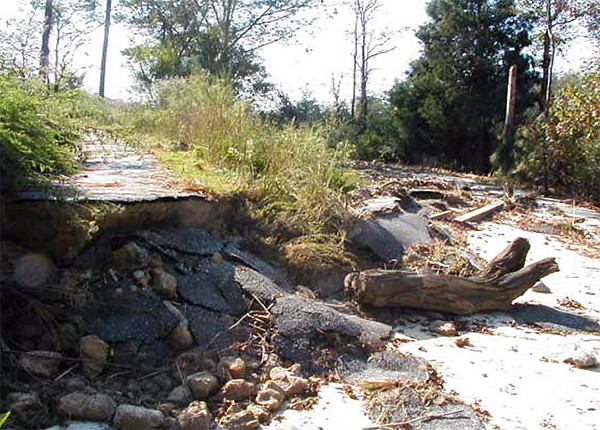Read Our Blogs
Remembering Hurricane Isabel
Stories of resourcefulness and resilience from park personnel
I had only been in the Northern Neck of Virginia for a few years when Isabel came along in 2003. There had been a few regional storms that knocked the power out and downed some trees, so when I learned a hurricane was coming to our area, I wondered, “How bad could it be?”
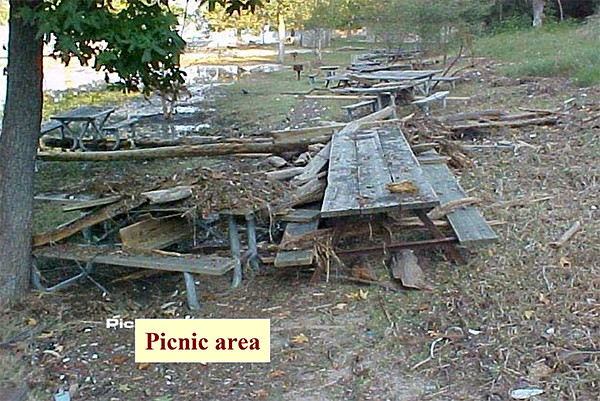
Westmoreland State Park - waterfront picnic area
Growing up in an area nicked named “Hurricane Alley” in North Carolina, I experienced quite a few bad storms in my time that rocked our little village, devastated homes and businesses, leaving us stranded without power and sometimes isolated for weeks. I was thinking at the time, that the storms here on the Potomac and Rappahannock Rivers would amount to nothing more than a tropical storm that was winding down. And, I had not heard of anyone talking about past storms so I did not think it would be that bad. However, I was about to get an education.
Back then my district office was located on the waterfront at Westmoreland State Park. With my storm-prepping expertise in mind, I arranged my office as best I could and made sure important things were up high enough in case it did flood, which I fully expected from the tidal Potomac. However, what I did not expect was the storm surge to ultimately surpass my raised office by many feet.
After the storm was over, I came back to my office to check things out. As I drove down the winding road to the river, toppled trees and debris were everywhere. Sometimes blocking roads and on top of cabins and buildings. It looked like the children's game Pick-Up Sticks. It was as though some great big hand had just picked up the trees and thrown them haphazardly across the park.
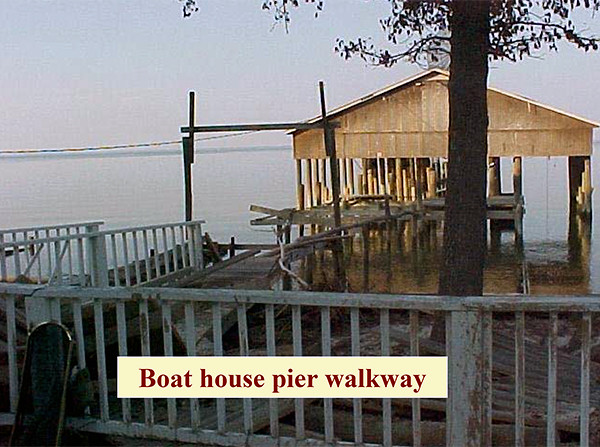
Westmoreland State Park - waterfront
When I reached the bottom of the hill, my heart sank. The waterfront parking area and beautiful picnic grounds were destroyed, and, in many places, still flooded. The boat house was gone, with its contents strewn across the sand. Park staff and even some of their family members were picking through the rubbish looking for salvageable items. I became very emotional at all the devastation, as did some of the other park staff. I will never forget walking into the Potomac River Retreat and how shocked and saddened I was at the site. There was enough sand inside the expansive, enclosed sunroom and waterfront main bedroom that it reached my knees. The ceiling-to-floor windows were gone, and the entire building had been flooded! The park had sustained damage beyond anyone’s expectations.
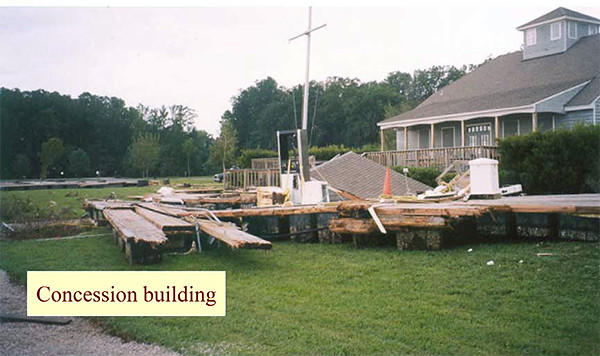
Leesylvania State Park - near the marina

Leesylvania State Park - footbridge
During her attack on Virginia, Isabel had not only paid a visit to Westmoreland State Park but all the state parks along the Potomac and Rappahannock Rivers. Caledon State Park lost an incredible number of trees, Leesylvania State Park sustained extensive damage to the marina area and Mason Neck State Park and Belle Isle State Park sustained storm surge damage, as well. Isabel also traveled along the York River visiting York River and Chippokes State Parks.
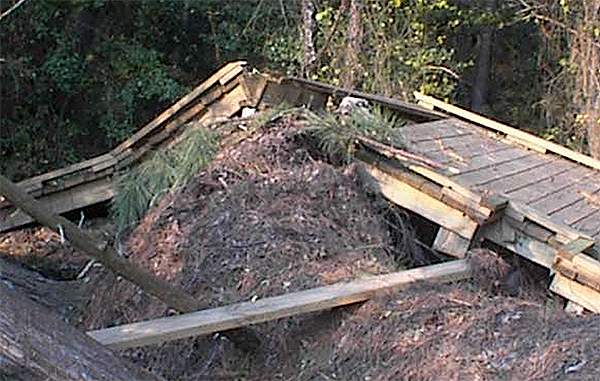
Belle Isle State Park - boardwalk
And of course, she made her presence known at First Landing, False Cape, and Kiptopeke State Parks. I was very surprised indeed that she had also put in an appearance further inland at Pocahontas State Park.
My colleagues also saw things they would never forget
Chain sawing a way in — and out — of York River
Brad Thomas, Chief Ranger at York River State Park said the park was so badly damaged, that it was closed until March of 2004.
“It seemed like every other tree came down in the park, blocking trails and roads. The trails took the hardest hit. It took me the whole next day to chain-saw my way into the park while the Park Manager, Tom Cervenack, sawed his way out. It took five days just to cut our way down to Croaker Landing. Fortunately, no trees fell on any buildings or facilities; however, since Isabel came during high tide, the storm surge was 8.2 feet above normal high tide. It actually pulled our creek dock off of its pilings and it floated away!
“During the storm, I and my family were hunkered down at the park residence watching the horizontal rainfall and the tulip poplar trees in the front sway back and forth,” Thomas continued. “We had no electricity (in fact, one tree fell, root ball and all, near the house and pulled up our main electric line). We were out of electricity for 14 days! We had to go to the local rec center to take showers and get meals from the Red Cross. No other trees fell in the yard, but I do remember being in the bathroom before it got dark and a big limb from an oak tree fell right near the window, just missing the house by a few feet. That oak limb still has not fully decomposed yet, 20 years later.”
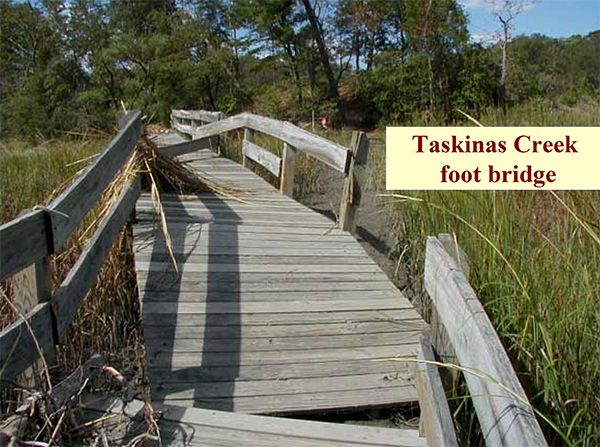
York River State Park - footbridge
Thomas also recalled his wife's excellent hearing skills. “She could probably hear a mouse stir on Christmas Eve if asked to do so. We were still hunkered down in the house, but now it was dark, and the only light was from candles and such. The wind was whipping outside, and my wife said, ‘Do you hear that?’ I said, ‘I hear wind. What do you hear?’ She said, ’No, it's a different sound. Like a freight train. I bet you we might have a tornado near us!’ I didn't believe her, but went to the bathroom with no windows at the center of the house anyway.
A few weeks later when I was out on Powhatan Forks Trail cutting trees, I noticed a circular area about 100 feet or so in diameter where trees had been knocked down in a circle on top of each other. It was the sign of a tornado microburst. This was about half a mile from my park residence. ‘What do you know,’ I said. ‘She was right!’
Playing Monopoly while trees fell “like dominos” at Westmoreland
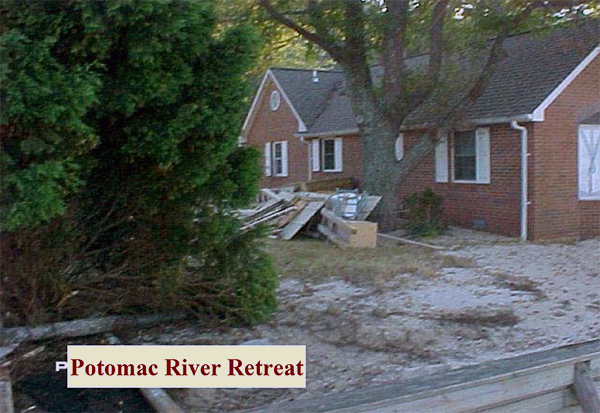
Westmoreland State Park - Potomac River Retreat
Steve Davis, Chief Ranger at the time, lived at Westmoreland State Park with his family, said his main memories were ones of awe and destruction. “We stayed in our residence after the park was closed due to the approaching hurricane. Power was lost around 4 p.m. Luckily, we had a gas grill, battery-operated lanterns, and had filled coolers with ice, food, and drinks.
I remember the wind picked up quickly as night fell. We started playing Monopoly to help pass the time,” Davis continued. “The whole time we could hear limbs hitting the house and trees falling around us. Luckily, none of the trees fell on the house, but it still made for a challenging game as all we could think about was the storm howling outside!
“Eventually, we decided to stop playing and just stayed in the family room talking and listening to storm. I don’t think we got much sleep. The next morning there were three huge poplar trees lying in our front yard. They had fallen like dominoes across the yard, away from the house. As we started walking around, all we could see were downed trees and debris spread throughout the park. We knew it would be days before power was restored and things were normal again.”
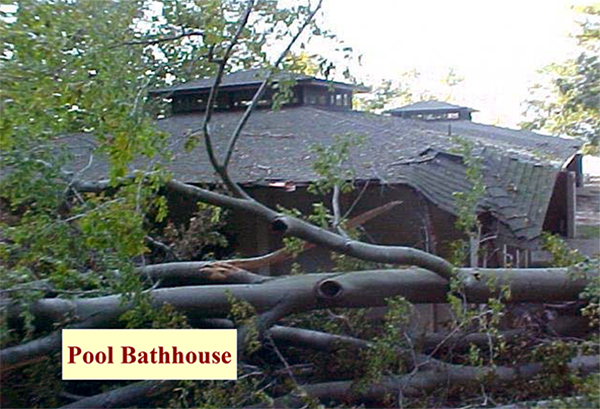
Westmoreland State Park - pool area
Davis said he was “amazed at the damage down there once the road had been cleared and we could get to the day-use area. The Potomac River Retreat walls had watermarks of 4- to 5 feet on them. Most of the furniture had been washed out of the structure. The boathouse had been demolished, with merchandise tossed all over the parking lot. The whole parking lot was covered in mud and debris.
“Power was out for almost three weeks and the park was closed for 2 months to allow for cleanup. There was a total of 33 power poles broken throughout the park. Practically all electrical wire had to be restrung. The Potomac River Retreat was closed for two and a half years while repairs were made. The interior basically had to be gutted and rebuilt.
“A contractor was hired to do most of the tree cleanup. They bought in a huge chipper and chipped up hundreds of dump truck loads of limbs and trees resulting in a huge mulch pile. Remnants of the pile still exist.
“Perhaps the most important result of Hurricane Isabel was the installation of the breakwaters along the day-use area. These proved to help alleviate some damage when Hurricane Irene struck years later. This was definitely an experience my family and I will not forget."
Davis also added, "It is neat to ride through the park now and see how the park has bounced back from that damage while at the same time remembering how it looked."
An underwater boardwalk at Mason Neck
Even parks like Mason Neck State Park that didn’t get severe wind damage still lost power and trees. Sammy Zambon, Mason Neck's Chief Ranger at the time, said, “The largest amount of damage came from the storm surge. Mason Neck experienced a 9 to 11-foot storm surge which overtopped and damaged the wetland boardwalks. One boardwalk that was under construction was completely swept away and ended up piled into the woods at the head of the wetlands!”

Caledon Natural Area (now State Park) storage building
Facts about Hurricane Isabel
- Strong winds from Hurricane Isabel extended from North Carolina to New England and westward to West Virginia.
- It left about 6 million people without power, some for several weeks, to a month, because of the downed trees
- Coastal areas suffered from waves and its powerful storm surge, with areas in eastern North Carolina and southeast Virginia reporting severe damage from both winds and the storm surge.
- According to the National Climatic Data Center, Hurricane Isabel resulted in $5.5 billion in damage and 51 deaths, of which 16 were directly related to the storm's effects.
- Isabel was the first major hurricane to threaten the Mid-Atlantic and Upper South since Hurricane Floyd in September 1999. Isabel's greatest effect was due to flood damage, the worst in some areas of Virginia since 1972's Hurricane Agnes. More than 60 million people were affected to some degree.
Recovery and preparing for future storms
It took a very long time for many of Virginia’s state parks to recover, but with the help of volunteers, including AmeriCorps NCCC, and dedicated staff, we were on the road to recovery.
I learned firsthand how devastating and destructive that type of storm can be in this part of Virginia. I now have a newfound respect when a hurricane is forecast for our area.
For more information on how to be prepared for storm surges and other types of flooding, visit https://www.dcr.virginia.gov/dam-safety-and-floodplains/floodplain-index.
If you have read the article and have a question, please email nancy.heltman@dcr.virginia.gov.


